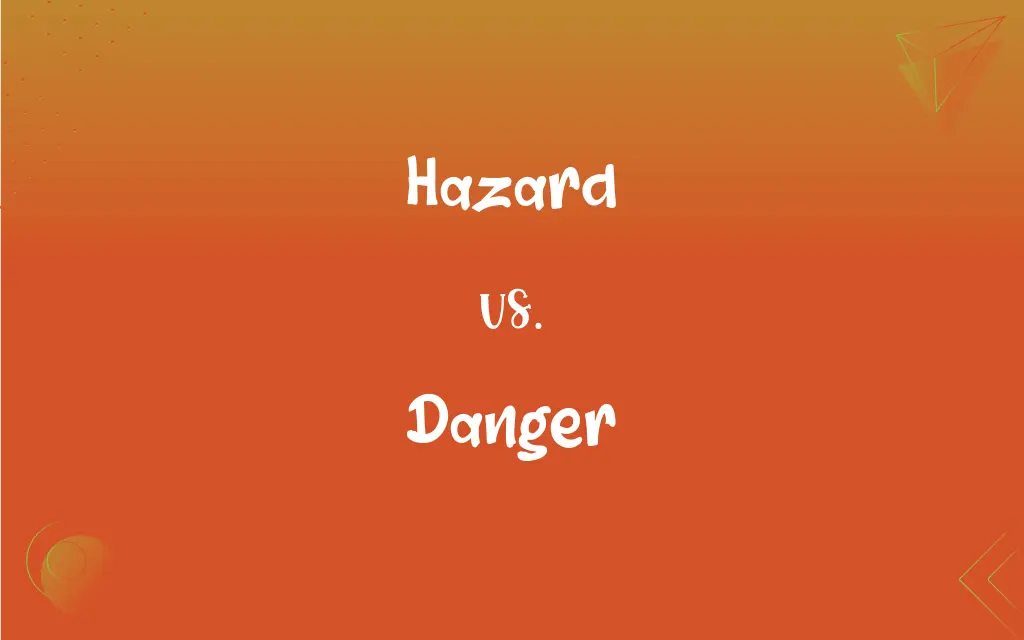Hazard vs. Danger: What's the Difference?
Edited by Aimie Carlson || By Janet White || Published on February 24, 2024
A hazard is a potential source of harm or adverse effect, while danger is the immediate risk of harm.

Key Differences
A hazard refers to something that could potentially cause harm or adverse health effects, like a chemical substance. Danger, on the other hand, implies an immediate risk or threat to safety, such as being close to a wild animal.
Hazards often need specific conditions to become dangerous, like a flammable material needing a spark. Danger is the realization of a hazard, where the harm is imminent, like a fire breaking out.
Identifying a hazard is about recognizing potential risk, such as an icy road. Danger signifies the higher likelihood of harm occurring, like skidding on that ice.
A hazard might not always lead to danger, but it indicates a possible threat, like exposed electrical wiring. Danger is when that threat becomes likely or actual, such as getting an electric shock.
Hazards can be mitigated or controlled, reducing the risk, like wearing protective gear. Danger requires immediate action to avoid harm, like moving away from a collapsing structure.
ADVERTISEMENT
Comparison Chart
Definition
Potential source of harm
Immediate risk of harm
Dependence
May not immediately lead to harm
Implies imminent harm
Example
Chemicals in a lab
Exposure to toxic fumes
Mitigation
Can often be controlled or minimized
Requires immediate action to avoid
Perception
Recognized as a potential risk
Felt as an immediate threat
ADVERTISEMENT
Hazard and Danger Definitions
Hazard
Hazard implies a risk of adverse effects.
Chemical storage presents a significant hazard in the workplace.
Danger
Danger involves exposure to harm or injury.
Walking alone at night in that area is a danger.
Hazard
Hazard can be a situation posing a level of threat.
Driving without headlights at night is a serious road hazard.
Danger
Danger is the presence of harm or injury risk.
The crumbling cliff edge posed a clear danger to hikers.
Hazard
Hazard can be physical, chemical, or environmental.
Asbestos in old buildings is a health hazard.
Danger
Danger implies immediate threat.
The riptide at the beach presented a real danger to swimmers.
Hazard
Hazard is a potential source of harm.
The icy sidewalk was a hazard to pedestrians.
Danger
Danger can be physical, situational, or environmental.
The approaching storm is a danger to coastal residents.
Hazard
Hazard often requires conditions to become harmful.
Dry forests are a fire hazard during droughts.
Danger
Danger is often urgent and requires immediate response.
The gas leak in the building was an immediate danger.
Hazard
A chance of being injured or harmed
Space travel is full of hazards.
Danger
Exposure or vulnerability to harm or risk.
Hazard
Risk or danger
A high degree of hazard.
Danger
A source or an instance of risk or peril.
FAQs
What is a hazard?
A potential source of harm or adverse effect.
Is a hazard the same as a risk?
Not exactly, risk is the likelihood of the hazard causing harm.
Are hazards always visible?
No, some hazards are not immediately apparent.
Can hazards be controlled?
Yes, through safety measures and precautions.
Can danger be predicted?
In some cases, especially if hazards are known.
Can a hazard always lead to danger?
Not always, it depends on conditions.
How can one respond to danger?
By taking immediate action to ensure safety.
Are dangers always obvious?
Not always, some dangers can be unexpected.
Is danger always immediate?
Typically, danger implies immediacy.
How do hazards become dangers?
When the conditions turn a potential risk into an actual one.
Can a hazard exist without leading to danger?
Yes, if it's properly managed or controlled.
What role does awareness play in hazards and dangers?
Awareness helps in identifying and avoiding both.
Are all dangers avoidable?
Not always, but many can be prevented.
Are there different types of hazards and dangers?
Yes, including physical, chemical, and environmental.
What is danger?
The immediate risk or presence of harm.
Can danger be mitigated?
Yes, by addressing the immediate threat.
Can education reduce hazards and dangers?
Yes, through knowledge and preventive strategies.
Is a slippery floor a hazard or danger?
It's a hazard that can become a danger if someone walks on it.
How important is preparation in dealing with hazards and dangers?
Preparation is key in reducing the impact of both.
How does one identify a hazard?
Through risk assessment and awareness.
About Author
Written by
Janet WhiteJanet White has been an esteemed writer and blogger for Difference Wiki. Holding a Master's degree in Science and Medical Journalism from the prestigious Boston University, she has consistently demonstrated her expertise and passion for her field. When she's not immersed in her work, Janet relishes her time exercising, delving into a good book, and cherishing moments with friends and family.
Edited by
Aimie CarlsonAimie Carlson, holding a master's degree in English literature, is a fervent English language enthusiast. She lends her writing talents to Difference Wiki, a prominent website that specializes in comparisons, offering readers insightful analyses that both captivate and inform.
































































